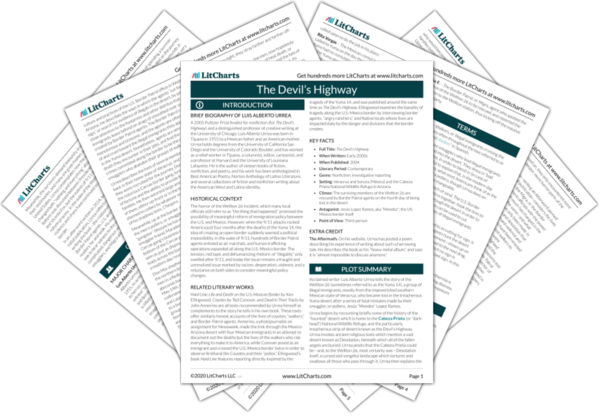“Coyote” has long been the most common term in Mexico for someone who smuggles people across the border, but The Devil’s Highway introduces readers to a new nomenclature, or “border slang.” What most Americans think of as coyotes—the men who smuggle illegal immigrants across the border in cars, vans, or on long desert treks—are now most commonly known as polleros, while the illegals they transport are known as pollos. Urrea is careful to note that the word for chicken, the animal, in Spanish is “gallina,” while the word for cooked chicken is “pollo.” Thus, pollos are “cooked” before they even set foot in the desert, and polleros are tasked with shepherding them across the desert. Coyotes are higher up on the “food chain” of border gangs, just as coyotes are, in the natural world, far above chickens. The fact that those who traverse the expanse of the border are referred to by nicknames taken from the animal world symbolizes the dehumanizing culture of the smuggling business in general. Most vulnerable are the “cooked chickens” at the bottom of the food chain, whose lives are considered both worthless and compromised from the outset of any smuggling journey. Fierce and wily coyotes prey upon the smaller, more defenseless chickens—and the symbolism of these identities speaks to the ruthlessness as well as the seeming inevitability of such power dynamics along the border.
Coyotes and Chickens Quotes in The Devil’s Highway
You’d be hard pressed to meet a Border Patrol agent in either southern Arizona sector who had not encountered death. All the agents seem to agree that the worst deaths are the young women and the children. The deaths, however, that fill the agents with the deepest rage are the deaths of illegals lured into the wasteland and then abandoned by their Coyotes.
From El Papalote, it seems like the myth of the big bad border is just a fairy tale. One step, and presto! You're in the EEUU. Los Estados Unidos. There's nothing there. No helicopters, no trucks, no soldiers. There's a tarantula, a creosote bush, a couple of beat saguaros dying of dry rot, some scattered bits of trash, old human and coyote turds in the bushes now mummified into little coal nuggets. Nothing. The smugglers tell the walkers it’s just a day’s walk to their pickup point. How bad can it be? A day of thirst, some physical struggle- they've lived like that all their lives.
The Mexican government’s border sign near Sasabe doesn’t actually say “Coyotes.” It uses the hipper slang of the border. It says, “Los Polleros.” A pollero would be a chicken-wrangler. The level of esteem the smugglers hold for their charges is stated plainly. They’re simply chickens. Of course, if you know Spanish, you know that the word for “chicken” is gallina. “Pollo” is usually reserved for something else. A pollo, as in arroz con pollo, has been cooked.












